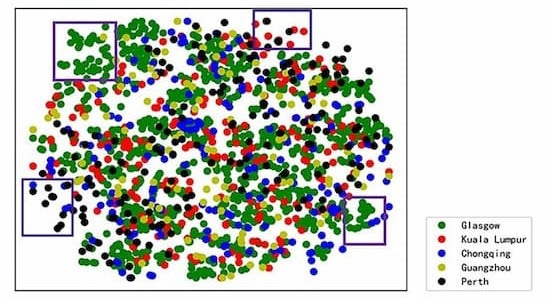An artificial intelligence (AI) model has been shown to have the capacity to forecast the best personalized anti-seizure medicine for individuals with recently diagnosed epilepsy, according to a Monash University-led study, believed to be the first in the world.
 2D plane shows the machine learning model is able to identify patterns between patients at the different centers. Image Credit: Monash University.
2D plane shows the machine learning model is able to identify patterns between patients at the different centers. Image Credit: Monash University.
When the prediction model is complete, these patients will not have to worry about taking anti-seizure medications or experiencing any side effects, saving them from the uncertainty of not knowing when their lives will return to normal.
An international collaboration under the direction of Professor Patrick Kwan, a neurologist and researcher from the Department of Neuroscience at Monash Central Clinical School, is “training” the deep-learning prediction model (deep learning is a type of machine learning).
The research has been published in the prestigious journal JAMA Neurology.
Seventy million individuals worldwide have epilepsy. According to Professor Kwan, selecting an anti-seizure medication for a patient currently involves a process of trial and error because clinicians cannot forecast which medication a specific patient will respond to.
If the patient doesn’t respond to the first treatment, quite a few will respond to the second or third one, meaning that they might have become seizure-free sooner if the ‘right’ drug was chosen at the outset. But if they get the wrong medication they still have seizures and may also get side-effects from it—they’re not getting the benefit and are getting harm from the drug.
Patrick Kwan, Professor, Neurologist and Researcher, Department of Neuroscience, Central Clinical School, Monash University
These side effects can include everything from allergies to psychiatric issues, or in the case of women who are fertile, birth abnormalities in the unborn child. Some patients develop drug-resistant epilepsy, which means that if identified early, they could be treated more swiftly with surgery, a device, or dietary changes rather than wasting years on ineffective treatments.
In five hospitals in Australia, Malaysia, China, and the UK, the model used clinical data on 1798 patients. The Monash Medical AI, under the direction of Associate Professor Zongyuan Ge, is creating it, and it is being trained on the Monash MASSIVE computing cluster.
Associate Professor Ge says, “We are seeing how the latest deep learning model is bridging itself from the computer-aided diagnosis now to the treatment domain, which is truly exciting.’’
According to Professor Kwan, the model’s ability to forecast the most effective treatment was “modest.” It received a score of 0.65 on the AUROC, a statistical performance metric with 1.0 being the best accurate.
Nonetheless that was more than what we expected—we were happy with that performance because only very basic clinical factors collected in routine clinical care were used to train this base model.
Patrick Kwan, Professor, Neurologist and Researcher, Department of Neuroscience, Central Clinical School, Monash University
It is getting better technically and with the use of more sophisticated data. To assist in choosing a treatment for epilepsy, the improved model will be put to the test in the national multicenter randomized controlled PERSONAL study (Personalized Selection of Medication for Newly Diagnosed Adult Epilepsy).
Dr. Zhibin Chen, Monash neuroscientist and biostatistician, played a vital role in the research.
This is believed to be a world-first model. It assures the predictability of choosing the optimal treatment for patients with newly diagnosed epilepsy. It will open the gate for personalizing the management of epilepsy.
Dr. Zhibin Chen, Neuroscientist and Biostatistician, Monash University
The model’s first author was Dr. Haris Hakeem, a Ph.D. candidate and Epilepsy Fellow at The Alfred, while Ph.D. candidates Wei Feng and Jiun Choong were instrumental in its development, according to Professor Kwan.
The PERSONAL trial was granted a $2.46 million NHMRC grant in the latest round of the NHMRC Clinical Trials and Cohort Studies Scheme funding.
The model is currently intended for adult patients with newly diagnosed epilepsy who are about to begin their first medication. Children have not been tested on it.
For those with more severe epilepsy, this model will serve as the foundation for additional models.
Journal Reference:
Hakeem, H., et al. (2022) Development and Validation of a Deep Learning Model for Predicting Treatment Response in Patients With Newly Diagnosed Epilepsy. JAMA Neurology. doi.org/10.1001/jamaneurol.2022.2514.